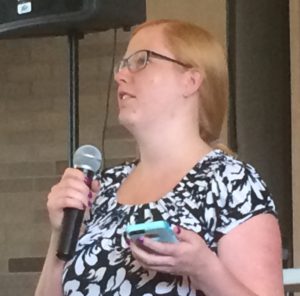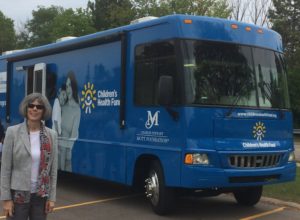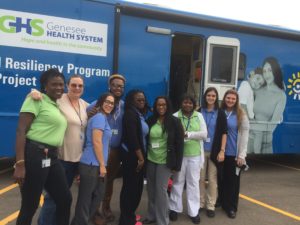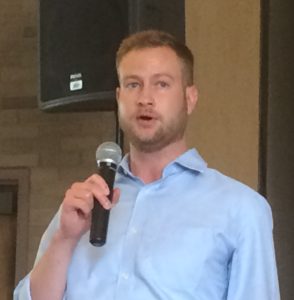By Jan Worth-Nelson
The water crisis has taken its toll on more than our pipes.
As Elizabeth Burtch, a supervisor at Genesee Health System puts it, “There is a lot of anxiety out there, a lot.”
And there’s what she calls “toxic stress,” leading to understandable but troubling reactions such as obsessive water hoarding, exacerbated physical symptoms, confusion, guilt and anger.
And for the most part, the precipitating triggers have been outside ourselves.
“Even if you weren’t personally impacted by the water, I think just the feeling of…what’s the next thing that’s going to come, when’s this other shoe going to drop” is in the air. And the result is a pervasive anxiety and depression that for some people can affect all other parts of life, she says. “All of it just compounds one thing on another.”
Combatting a stigma
“Most people won’t say that they have anxiety – they might not even know what it is,” Burtch says. And even if they do know what it is, she adds, there’s “definitely a huge stigma” around asking for help.

Genesee Health System supervisor Elizabeth Burtch advocating for taking help to the people.
Burtch says she and many others on the front line response to the crisis understood fairly early on that outreach to those experiencing emotional and psychological distress was needed – especially special populations that might be falling through the cracks – and continue to be.
“There are folks who are struggling,” she says, “and who may not have the coping skills to be able to handle all this in a healthy way like talking to someone or going to seek help.”
Burtch and her colleagues at Genesee Health System (previously Community Mental Health) began exploring ways to take their resources and supportive therapies to the people.
And that led to a big blue bus.

Kathleen Falk, Region V director of the U.S. Department of Health and Human Services and a frequent visitor to Flint during the water crisis, was at the Flint Recovery Group meeting the day the Mobile Mental Health Unit first pulled up outside City Hall.
One of the most visible signs of community assistance, the 36-foot-long RV is called the Mobile Mental Health Unit, launched in September with a ceremony at the Flint Farmers’ Market.
Its trained crew of mental health clinicians are all but one Flint residents who have experienced the water crisis first hand. After a period of training and planning, they now are making about 300 contacts a week with residents at health fairs, churches, libraries, schools, senior centers – wherever they are invited.
It came from Katrina
The bus came to Flint from New Orleans, where it last served victims of Hurricane Katrina. When it got here it was painted bright blue by American RV, with a huge decal by Barry’s Signs of a smiling young woman cuddling a small child.
The driver of the bus is Jacqueline Bonner, who has a fortuitous combination of social work training and experience as an MTA and school bus driver.
The mobile unit crew in addition to the driver includes a full-time clinical therapist, two full-time case managers and a half-time administrative support person.

Part of the Mobile Mental Health Unit team
This crew is backed up by a dozen or so other outreach workers in different categories – some specializing in helping connect children and families with resources, others trained to respond clinically to those with specific psychological or emotional problems.
“They have pretty much been working 24-7,” Burtch says. Initial steps have included door-to-door canvassing with information on available resources and giving people an opportunity to meet the outreach workers and see inside the bus.
The most frequent patrons of the Mobile Mental Health unit so far, Burtch says, are the elderly, many of whom because of limited mobility or isolation might have missed out on news of what’s happened or what resources are available.
Another troubled group, she says, are parents who feel guilty if their children were exposed to lead-tainted water before the breadth of the tragedy became clear.
The team has developed a five-week curriculum for children and adults to be offered on the bus. Burtch says a resident could drop in on any one of them and get something out of it.
“It’s all about what we would call emotional regulation or coping skill acquisition,” she says. “What do you do when you’re stressed? How do you know when your child is stressed?
“They can talk about what they are experiencing and what actual steps they can take.” No medications are prescribed, she noted, and no psychiatrists or physicians are involved. However, team members are trained to diagnose more serious symptoms, she said, and to guide those who might need it into outpatient care and follow up.
“What I’m hearing from my staff is that a lot of people want to vent – they don’t feel heard,” Burtch says.“They just want to talk – they’re confused. People are coming in and out testing their water, they don’t know who it is, what’s happening – we can help clear up a lot of that confusion.”
Using a group approach
The treatment model is “very group oriented,” she says, for therapeutic reasons. People might want to talk about how to manage their child’s behavior, for example, and a group approach sometimes creates a safer atmosphere to talk about it when people find out they are not alone. She also hopes what residents might learn could extrapolate to other situations beyond the water crisis.
The unit is on loan from the Children’s Health Fund, which initially approached local officials with offers of assistance. Other funding to support the bus and its crew has come from The C.S. Mott Foundation, the Flinn Foundation, the Ruth Mott Foundation, and the Community Foundation of Greater Flint.
Crucial support came from part of a $475,000 grant from the federal Substance Abuse and Mental Health Services Administration (SAMHSA) called SERG, or SAMHSA Emergency Response Grant.

Genesee Health System Supervisor Troy Brown described the Mobile Mental Health Unit and introduced the team at a recent meeting of the Flint Water Recovery Group.
Troy Brown, supervisor of community outreach, says the team is developing a schedule for the mobile unit’s travels around town, testing out the most opportune times to be at sites like the Greater Holy Temple or Bethel United Methodist “since we only have one Mobile Unit and cannot be at both places at once.”
“There are also many events in the community that we are invited to attend,” Brown adds. “Our mobile unit has had a presence at several events but those are at times difficult to schedule more than a week or two in advance. Setting up a consistent schedule is absolutely priority at this point and something we are working hard to accomplish.”
One of the strengths of the mobile outreach program, Burtch says, is that the workers themselves are local residents who have been living through the water crisis every day themselves. Several graduated from UM – Flint, some own homes here, some have parents or children or grandchildren affected by the crisis.
“They have empathy,” she says. “Are they angry about what happened? Yes. Do they feel betrayed? Yes. We stress to them, ‘you are a resident – you are allowed to have whatever feelings you have.’”
“At the same time, when you’re on the clock, your job is to build relationships, and then we hope you will come back in and talk about it.”
Some, like Melissa Mays, one of three “family navigators” involved with the program, came to their outreach position after months as “water warriors,” advocates and protestors.
“It has been phenomenal” working with the outreach efforts, Mays says. “It’s a great honor.”
A group of the outreach workers, introducing themselves recently to the Flint Recovery Group at City Hall, stressed they were motivated by their commitments to the city – through their children, the homes they own, their hopes that they can play a role in helping the city recover.
This sturdy group of Flint residents have found paying work, an outgrowth of the flow of funds into the city, while offering significant assistance to others. They are being paid $18/hour through the grant programs, on a one-year contract which program organizers hope might be continued.
A surprise serendipity: collaboration
One development that heartens and impresses Burtch most is how her own organization, along with dozens of other social service providers from the Food Bank to many churches to Red Cross and United Way, government representatives and philanthropic organizations locally and nationally have come together in ways she’s never seen before or even imagined.
That has been gratifying, she says.
For instance, she said, “I never thought that I would be able to call EPA,” reflecting on how the influx of government and aid workers have interacted with her teams. “All of us have such a great relationship now – we all just want to help this community.
“I have never seen this kind of collaboration among agencies and professionals – it’s amazing,” she said.
EVM Editor Jan Worth-Nelson can be reached at janworth1118@gmail.com.


You must be logged in to post a comment.